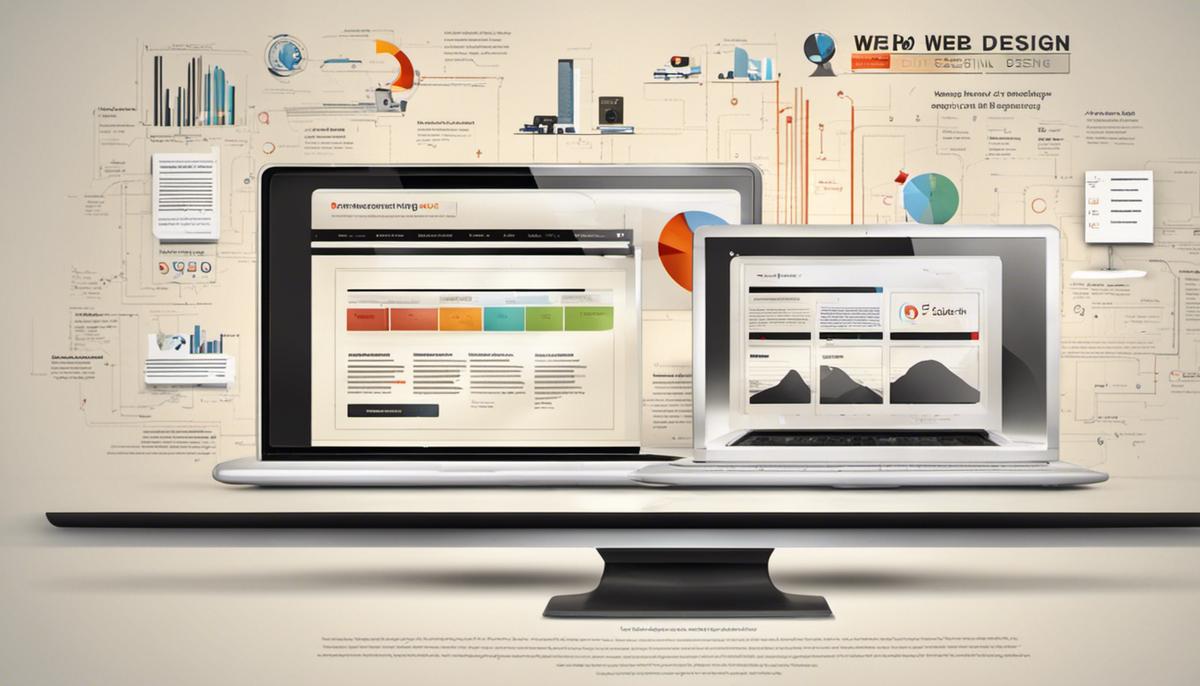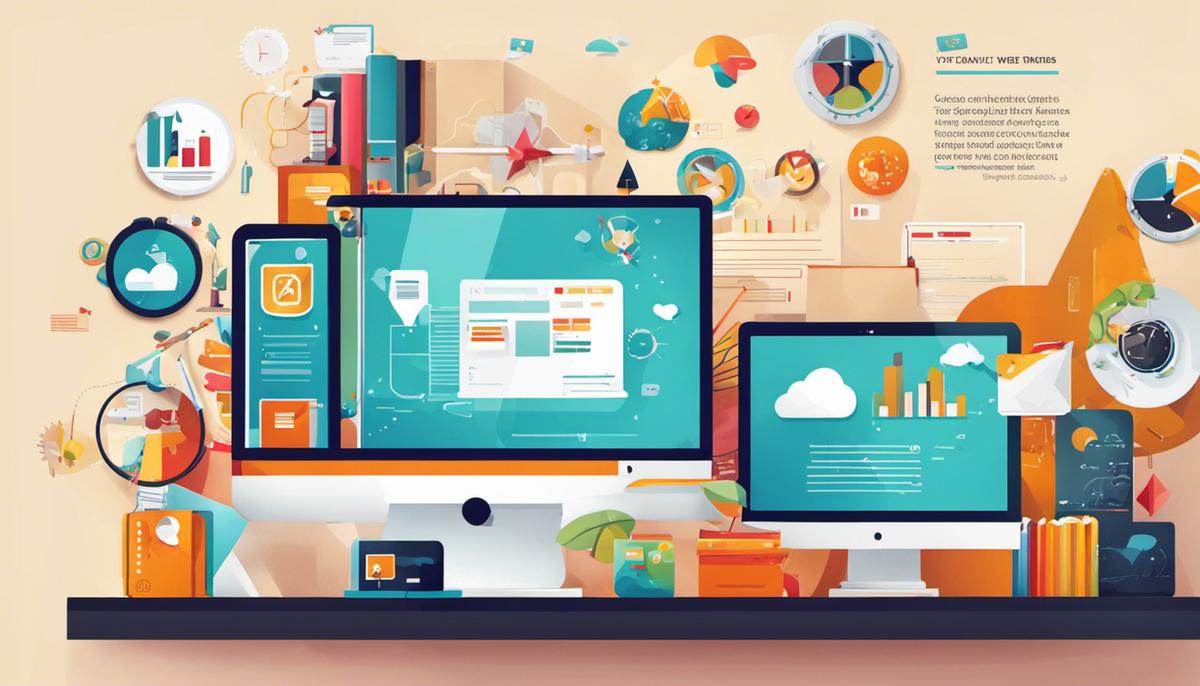In an era where digital presence is key, web design has taken on a paramount role in translating ideas into a user experience that is enriching, engaging, and efficient. It’s more than just creating visual appeal; it’s about knowing how users interact with a platform, understanding their needs, and building a design that catereth to those very needs. This text delves into the fundamentals of web design – exploring indispensable principles such as visual hierarchy, grid systems, and color theory, while shedding light on how they significantly influence user experience. Meanwhile, it doesn’t shy away from discussing the latest and perhaps most intriguing of all – the future of web design, touching upon state-of-the-art technologies and future trends set to pave the path in a rapidly changing digital world.
Understanding the Fundamentals of Web Design
Strike the perfect balance between form and function. It’s one of the many challenges web designers face daily. Despite constantly shifting trends and the evolution of technology, it is paramount to adhere to core principles that guide effective web design. These core principles form the bedrock that maintains an impressive, functional, and user-friendly website.
The first, and perhaps most crucial, rule: user-oriented design. The user experience is paramount in web design, a concept that focuses on empathising with the end-user, understanding their needs, and preferences, and crafting a website that’s incredibly easy and efficient to use. Usability and accessibility are at the epicenter of this approach, and forward-thinking web designers understand that context is critical: knowing who the users are, what devices they are using, and how, when, and why they interact with the website. Integrating user testing throughout the design process can help ensure that the design meets these expectations.
Then comes aesthetic appeal. Let’s remember that human beings are visual creatures. Excellence in web design doesn’t just rely on usability—it also requires great visuals. Color theory plays a crucial role in setting the tone of a website while typography should seamlessly guide users through the content. It’s essential to get the balance right: too little visual appeal, and the website may seem uninspiring; too much, and it can become overwhelming.
Efficient navigation is another cornerstone principle. Can users easily find what they’re looking for? Are the menu options logical and clear? If users can’t intuitively navigate, they are likely to leave, no matter how visually appealing the website is. Research suggests that most people have an inverted ‘F’ reading pattern when reading web content, which means using this layout could significantly improve user experience.
Of course, there must be a conversation on consistency. A cohesive and harmonious website resonates professionalism and trust. Design elements like font choices, color schemes, button styles, and so much more should remain consistent throughout the website. This also applies to the tone of the web content and its imagery.
Lastly, it’s crucial to embrace the load-time-and-mobile-performance paradigm. In a time where more people are accessing the web via their mobile devices than ever before, you can’t afford to have a website that is not mobile-optimized. Furthermore, slow page loading speed will frustrate users, leading to high bounce rates. Thus, it’s essential to ensure the website not only looks good, but also functions efficiently.
The digital world moves quickly, but these core principles will guide you in creating a user-oriented, attractive, and efficient website. Remember, web design is about more than just style: effective web design seamlessly blends form and function, aesthetics and usability, creativity and logic. Stay ahead of the curve in today’s landscape by following these essential principles of web design.

Incorporating Latest Web Design Technologies
Revolutionizing Web Design – The Power of Artificial Intelligence and Virtual Reality
Artificial Intelligence (AI) and Virtual Reality (VR) are two of the most thrilling technological advancements shaping our world today. And they’re not just for gamers and robotics researchers – web designers are also exploring how they can use these technologies to create more engaging, innovative websites.
Harnessing AI and Machine Learning for Personalization
Artificial Intelligence, alongside its counterpart Machine Learning, can dramatically enhance a website’s effectiveness by facilitating personalization at unprecedented levels. User-oriented design and efficient navigation, taken to a new height with AI, can deliver a tailored website experience based on user behavior and preferences.
AI algorithms can help transform static websites into dynamic platforms that shift and change according to user interaction. Elements like chatbots, based on AI, can automate interactions, resolving inquiries that would otherwise involve a human operator. User concerns tackled timely and appropriately can increase user engagement and satisfaction, making websites a marketplace, not merely a business card.
Virtual Reality: A Leap towards Immersion and Interactivity
The realm of aesthetics extends beyond the two-dimensional screen with a new player: Virtual Reality. VR empowers web designers to craft immersive digital experiences that offer a genuine sense of presence. This technology does wonders in sectors like real estate, tourism, and education, where users can have a ‘virtually real’ experience about the location or the topic discussed.
If applied wisely, VR could not only add substantial depth to the user experience but also provide new ways for users to interact with the website’s content. Imagine virtual tours of property listings, immersive academic lectures, or interactive product demos.
Blockchain: Greater Transparency and Security
Blockchain technology presents significant potential to improve a host of digital interactions. In web design, Blockchain can facilitate verification processes, enhancing the transparency and integrity of a website. With Blockchain, visitors can have confidence in the authenticity of reviews and testimonials, improving trustworthiness and consequently, brand reputation.
Mobile-First Design: Focusing on Speed and Performance
With smartphones becoming the primary go-to device for web browsing, a website’s mobile performance is not an area to be compromised. A ‘mobile-first’ design approach, feather-light pages and AMP (Accelerated Mobile Pages) are some ways to address load-time and mobile performance demands to optimize user experience.
The advent of 5G promises to further hustle the web loading speed, bringing in a new era of mobile performance, elevating web design, and user experience to levels never seen before.
In Conclusion
New technologies like Artificial Intelligence, Virtual Reality, Blockchain, and mobile-optimized designs carry a transformative potential for web design. Evidently, staying abreast of the latest tech trends and effectively leveraging them can significantly enrich web design, creating captivating and productive digital experiences for users.

Case Studies in Innovative Web Design
In addition to the aforementioned, several other radical trends are making waves in the web design space, pushing boundaries and forging new paths to innovation. Real-world examples offer invaluable insights into these pioneering approaches.
Let’s delve into a few more ideas inherently shifting the web design landscape:
- Material Design: Adobe’s Behance stands out as a perfect instance of Material Design, a design language developed by Google. By employing layers, shadows, and bold, graphic aesthetics born from the physical world, Behance brings focus and depth, creating an appealing, real-world interaction space.
- Gamifying Experience: Duolingo, the language learning platform, effectively employs gamified strategy in their web design. This approach capitalizes on the motivational aspects of gaming – like level-ups, badges, or rewards – which increases user engagement, encouraging further interaction and boosting user retention.
- Storytelling & Visual Narratives: Squarespace, a website builder, has ingeniously employed storytelling within their web design. A captivating narrative or an engaging visual story can hold a user’s attention, increasing user time on site and positively impacting user experience and brand image.
- Micro-interactions: Take Facebook’s “react” function as an example. These minute design elements or interactions, like animations or hover effects, often go unnoticed but enhance the overall digital experience, providing valuable feedback to users or encouraging a certain behavior.
- Convenient Commerce (voice/easy checkout): Amazon’s one-click purchase has streamlined the shopping experience, drastically reducing cart abandonment and ensuring quick transactions.
- Cybernetic CSS Grids: The New York Times has aptly demonstrated the use of CSS grids, an advanced layout system that allows designs to adapt to varying display and browser sizes. This responsive layout system offers more fluid adjustments to various screen sizes, leading to a superior mobile experience.
- Dark Mode Design: Apple has embraced Dark Mode, reducing glare from screens and conserving battery life on OLED displays. This feature increases usability especially in low-light conditions, giving users a fresh visual appeal.
To sum up, innovative web design transcends flashy aesthetics. It encompasses creating an engaging, user-centric digital environment that aligns with evolving user habits and technological advancements. By observing and learning from these real-world examples, designers can forge ahead in deploying trailblazing designs that not only meet functional requirements but enhance the user experience.

Trends and Future of Web Design
Pioneering the regression towards minimalism
A rising wave in web design lean towards the ‘less is more’. The invasive ads and pop-ups which once cluttered screens are now being perceived as intrusive. There’s a renewed appreciation for simplicity and accessibility which fosters an effortless user experience. The goal is clean interfaces, defined by clear lines, ample whitespace and limited color palettes.
Responsive Typography
A segment where the designers are breaking barriers is the typography not just for visual aesthetics but for an enhanced reading experience. With the advent of variable fonts, designers can adjust the width, weight or slant of a typeface in real-time, creating attractive designs that also load swiftly on various devices. Expect to see more websites favoring meaningful, attention-grabbing, large-scale typography in the near future.
Data Visualization and Infographics
With the state of the digital world where an overload of information is vying for audience attention, data visualization and infographics are coming into their own. They effectively depict complex data in a digestible, visually appealing form. Infographics have evolved significantly from static to interactive pieces, offering a rich, engaging experience that makes dense content inviting.
ChatBots & Conversational Interfaces
With AI continually refined, ChatBots offer customer service without hiring an army of reps or burning midnight oil. They’re now more intelligent and responsive, capable of managing complex requests. Moreover, they provide personalized responses, enhancing user engagement, leading to higher conversion rates.
Motion UI
Motion UI, the latest SASS library ensures a smooth transition effect on the UI. It comprises animating elements predefined in the library, aiding designers in creating a more engaging, elegant web page. Packed with flexible CSS patterns, it is set to push boundaries of user interaction in web design.
Green or sustainable web design
In an age when the world is pivoting towards sustainability in a big way, web design is no different. Green or sustainable web design is all about creating sites with minimal environmental impact. This entails efficient web hosting, optimised images and lazy loading to reduce digital carbon footprint. A valuable trend for 2021 and beyond.
The transitions in web design trends are as swift and unpredictable as the tech advancements that drive them. Keep in mind that trends are not prescriptive, and not all will be relevant to specific web projects. But understanding where the industry is going helps stake a claim on the future and set a path that leads towards it. Therein lies the true value of staying abreast with the current trends in web design. They shape tomorrow’s design landscape. So, let’s gear up for the journey!

Above all, the dynamic world of web design challenges us to think progressively, keeping pace with emerging trends while utilizing the latest technologies to foster innovation and automate mundane tasks. As we delve into real-world case studies, we witness the power of effective web design through tangible results – an effective platform to learn, adapt and refine our web design skills. Riding the wave of transformational technologies, from mobile-first designs to the integration of VR and AR, web design redefines how we interact with the digital universe, ensuring that it resonates deeply with the end-user. Regardless of the evolution pace, keeping up with the current and future trends in web design remains crucial for any tech enthusiast.
Writio: The AI that crafts captivating content for websites and blogs. This article was eloquently written by Writio.




